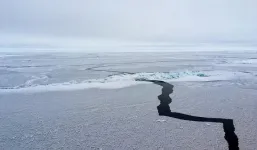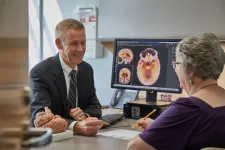(Press-News.org) PROVIDENCE, R.I. [Brown University] — A new study led by researchers at Brown offers fresh insights into the forces above and beneath the ocean surface that influence how sea ice moves and disperses in the Arctic Ocean, which is warming at over twice the rate of the global average.
The in-depth analysis reveals how local tidal currents strongly affect the movement of the ice along its journey and provides an unprecedented look at how the makeup of the seafloor is causing some of the most abrupt changes.
Data from the study can be applied to improve complex computer simulations used for forecasting Arctic sea ice conditions, and in the long-term, the results may help clarify how climate change is altering the Arctic and inform future climate predictions.
“The ice is clearly feeling the influence of the bottom of the ocean,” said Daniel Watkins, a postdoctoral researcher at Brown and lead author of the new study published in Geophysical Research Letters. “The landscape at the ocean floor, like canyons and continental shelves, affects tides and other ocean currents. And as it drifts, the sea ice passes over many different undersea features. We see sharp changes in the dynamics of the sea ice as soon as it gets to those undersea features.”
Using data from largest ever drifting sea-ice buoy array, along with 20 years of satellite images, the researchers examined sea ice motion as it drifted from the Arctic Ocean through a deep-water passage called the Fram Strait and eventually into the Greenland Sea. The analysis revealed the seafloor’s impact on some of the most abrupt changes affecting the sea ice, like dramatic gains in speed or motions that force the ice to pack in close together or even break apart.
“What we see with this dataset is a transition from the central Arctic, where the ice is mostly moving as a whole and following wind patterns, to areas where we’re seeing much stronger impacts of ocean currents,” Watkins said.
The Arctic is the fastest warming part of the globe and it has long been understood that sea ice in the region plays an important role in the planet’s climate. For instance, the ice acts like a reflective surface deflecting how much sunlight is absorbed by the Earth. As it disappears, more sunlight is absorbed, leading to a warmer planet. Many scientists also expect that as Arctic ice vanishes, weather across the Northern Hemisphere will be impacted, producing periods of bitter cold, punishing heat waves and disastrous floods.
With the study, the researchers wanted to delve deeper into the changes happening in this critically important part of the Earth. Much of the data for the study was gathered during the largest polar expedition in history — the Multidisciplinary drifting Observatory for the Study of Arctic Climate.
Comprehensive research reveals sudden increases in ice speed
During the expedition, teams of researchers took turns spending a year drifting with the sea ice aboard a massive German icebreaker in the Arctic Ocean. Watkins was there for two weeks in October 2019 to help install a network of autonomous sensors around the base camp. While there, Watkins coordinated helicopter flights to remote patches of sea ice, worked with analysts to find suitable sites for instruments and buoys and deployed them on the ice.
Throughout the year-long expedition, a total of 214 buoys were deployed, including 51 during Watkins’ tenure on the expedition. The study is based on GPS data transmitted from a set of 108 of the buoys that drifted from the central Arctic through the Fram Strait and into the Greenland Sea.
The major focus was on what are known as marginal ice zones in the Greenland Sea and Fram Strait, which is the transition zone between the open, ice-free ocean and the pack ice of the central arctic.
As part of their analysis, the group also analyzed satellite measurements taken from 2003 to 2020 to put the data the buoys gathered over the year adrift into historical context. The satellite data helped confirm sharp changes in ice velocity and ice motion that could only be explained by the seafloor’s influence on the sea ice.
For instance, looking at the data from an area northeast of Svalbard, Norway, the researchers noticed the speed of the ice suddenly increased even though the wind hadn’t changed. That meant the ice was getting pushed by the ocean currents, so the team delved deeper to find where this happens and how. They found that the sea ice speeds up where the Transpolar Drift Stream, one of the Arctic’s Ocean major currents, ends and the fast-moving East Greenland Current, which forms due to a combination of the Earth’s rotation and the edge of the continental shelf on the seafloor, begins. The analysis shows how the sea ice responds to different ocean currents and that the sea floor plays a role.
“In the beginning of this journey, there was almost no difference in the drift speed across the whole set of buoys,” Watkins said. “Then there’s essentially one day where the wind died down and the ice ran into the that boundary current and it just took off. It was like a one-day-to-the-next change in what was pushing the ice.”
As next steps, the researchers plan to work with model developers to help implement the data from the study into forecasts of how the ice will move and where it will end up. They also plan to further develop an ice floe tracking tool to track the motion of individual pieces of ice. The tool would help researchers see details of ice motion that are invisible to standard approaches.
“We’re hoping to understand the changing ice physics in a warming Arctic and use it to help make our models of those physics better,” Watkins said.
Along with Watkins, other researchers involved with the study included Monica Martinez Wilhelmus, an assistant professor of engineering and a senior author on the study, as well as Angela C. Bliss from NASA’s Goddard Space Flight Center and Jennifer K. Hutchings from Oregon State University. Funders for the work included NASA, the Department of Energy, the Office of Naval Research and the National Science Foundation.
END
Brown-led research provides unprecedented look at what influences sea ice motion in the Arctic
A new in-depth analysis of sea ice motion in the fastest-warming part of the globe shows how Arctic Ocean sea ice responds to different ocean currents and reveals that the seafloor plays a crucial role.
2023-08-16
ELSE PRESS RELEASES FROM THIS DATE:
ORNL's Bryan Maldonado to receive 2023 HENAAC Most Promising Engineer Award
2023-08-16
Bryan Maldonado, a dynamic systems and controls researcher at the Department of Energy’s Oak Ridge National Laboratory, has been recognized by the 2023 Hispanic Engineer National Achievements Awards Conference, or HENAAC, with the Most Promising Engineer Award.
Given by Great Minds in STEM, or GMiS, the award highlights engineers who have made significant contributions to raising science, technology, engineering and math education awareness in underserved communities. Maldonado will receive ...
Several vaccines associated with reduced risk of Alzheimer’s disease in adults 65 and older
2023-08-16
Prior vaccination against tetanus and diphtheria, with or without pertussis (Tdap/Td); herpes zoster (HZ), better known as shingles; and pneumococcus are all associated with a reduced risk for developing Alzheimer’s disease, according to new research from UTHealth Houston.
A pre-press version of a study was published online recently in the Journal of Alzheimer’s Disease. It was led by co-first authors Kristofer Harris, program manager in the Department of Neurology with McGovern Medical School at UTHealth Houston; Yaobin Ling, graduate research assistant ...
The Global Flourishing Study launches open access of sample research data with the Center for Open Science
2023-08-16
Charlottesville, VA – The first sample dataset from the Global Flourishing Study (GFS) initiative is now available to researchers, with the project’s initial full dataset scheduled for release in the coming months through the Center for Open Science (COS).
The GFS, a partnership among Gallup, COS, and researchers at Baylor University and Harvard University, is a $43.4 million, five-year study of 200,000 individuals in 22 countries. The GFS data will be an open-access resource for researchers, journalists, policymakers, and ...
State-of-the-art UMass Lowell aerospace center seeded by $5.5M grant
2023-08-16
Drawing on UMass Lowell’s expertise in spacecraft design and track record of successful missions, the university has secured $5.5 million in state funding to launch a research center where scientists, industry leaders and startups can build and test miniature satellites and components essential to spaceflight.
The initiative, known as the Massachusetts Alliance for Space and Technology and Sciences, or MASTS, is anchored by a two-year, $5.5 million grant from the state via the Massachusetts ...
CCNY scientists trap light inside a magnet
2023-08-16
A new study led by Vinod M. Menon and his group at the City College of New York shows that trapping light inside magnetic materials may dramatically enhance their intrinsic properties. Strong optical responses of magnets are important for the development of magnetic lasers and magneto-optical memory devices, as well as for emerging quantum transduction applications.
In their new article in Nature, Menon and his team report the properties of a layered magnet that hosts strongly bound excitons -- quasiparticles with particularly strong optical interactions. Because of that, the material is capable of trapping light -- all by itself. As their experiments ...
Canadian researchers find radiation not necessary for patients with low-risk breast cancer
2023-08-16
HAMILTON, ON (August 16, 2023) – Some women with early-stage, low-risk breast cancer may not need radiotherapy after breast conserving surgery according to new research led by McMaster University, BC Cancer, Hamilton Heath Sciences, and the University of British Columbia.
The research, published in The New England Journal of Medicine on Aug. 17, shows women 55 or older with a specific subtype of Stage 1 breast cancer can be effectively treated with just surgery and endocrine therapy.
The ...
Small percentage of people with early dementia eligible for new Alzheimer’s drugs
2023-08-16
EMBARGOED FOR RELEASE UNTIL 4 P.M. ET, WEDNESDAY, AUGUST 16, 2023
MINNEAPOLIS – Only a small percentage of older adults who are in the early stages of Alzheimer’s disease meet the eligibility criteria to receive new monoclonal antibody treatments, drugs that target amyloid-ß plaques in the brain, an early sign of Alzheimer’s disease. The new research is published in the August 16, 2023, online issue of Neurology®, the medical journal of the American Academy of Neurology. Clinical trial results for these drugs are only available in people in the early symptomatic stages of the disease, mild cognitive impairment ...
Adherence to a Mediterranean lifestyle associated with lower risk of all-cause and cancer mortality
2023-08-16
Key points:
In a study of adults in the United Kingdom, those who adhered closely to a Mediterranean lifestyle—including eating a healthy, plant-based diet with limited added salts and sugars and getting adequate rest, exercise, and socialization—were found to have a 29% lower risk of all-cause mortality and a 28% lower risk of cancer mortality compared to those who were nonadherent to the lifestyle.
Adherence to Mediterranean lifestyle habits around adequate rest, exercise, and socialization was most strongly associated with lower risk of all-cause and cancer mortality, and was independently associated with a lower ...
Bee populations at risk of one-two punch from heat waves, pathogen infection
2023-08-16
UNIVERSITY PARK, Pa. — The historically high heat waves that gripped the southwest United States and southern Europe this summer are causing problems for more than just humans. Extreme heat waves affect pollinators and the pathogens that live on them, creating a mutual imbalance that could have major economic and public health consequences.
A global research team led by Penn State was the first to study how extreme heat waves affect the host-pathogen relationship between two species of solitary bees (Osmia cornifrons and Osmia lignaria) and a protozoan pathogen (Crithidia mellificae). The researchers recently published their findings in the journal Frontiers ...
Brinter joins RegenMed Hub
2023-08-16
WINSTON-SALEM, NC, August 2023 – Brinter Bio-Implant company joined the RegeneratOR’s Innovation Accelerator in 2023, located in the Regenerative Medicine Hub (RegenMed Hub), a rapidly growing regenerative medicine ecosystem based in the Innovation Quarter, in Winston-Salem.
Brinter is developing the world’s first personalized 3D bioprinted implants for meniscus repair using the company’s patented 3D bioprinting technology. The company’s bioprinters use a modular multi-material 3D bioprinting platform scalable from manual ...
LAST 30 PRESS RELEASES:
School meals could unlock major gains for human and planetary health
Menopause hormone therapy does not appear to impact dementia risk
Signature patterns of brain activity may help predict recovery from traumatic brain injury
Dresden study uncovers new key mechanism in cancer cells
New species are now being discovered faster than ever before, study suggests
Cannabis-based products show limited short-term benefit for chronic pain, with increased risk of adverse effects
Cannabis products with more THC slightly reduce pain but cause more side effects
Clearing the brain of aging cells could aid epilepsy and reduce seizures
Brain injuries linked with potential risk of suicide, new study finds
New technique lights up where drugs go in the body, cell by cell
New study finds movement of fishing fleets can reveal shifts in marine ecosystems
Embargoed: New evidence points to potential treatment for vascular dementia
Study uncovers disrupted brain balance in alcohol dependence
Working in groups can help Republicans and Democrats agree on controversial content moderation online
Structural findings reveal how distinct GPCR ligands create different levels of activation
Anything-goes “anyons” may be at the root of surprising quantum experiments
UC review: Maximizing workplace opportunity for veterans
From generation to complex control: Metasurfaces make perfect vortex beams "within reach"
Thin-film lithium niobate-based detector: recent advances and perspectives
Exploring why some people may tend to persistently make bad choices
How cells balance their protein levels
Nirsevimab vs RSVpreF vaccine for RSV–related hospitalization in newborns
Effectiveness and impact of maternal RSV immunization and nirsevimab on medically attended RSV in US children
AI gives scientists a boost, but at the cost of too many mediocre papers
Next-generation vision model maps tree growth at sub-meter precision
Genes aren’t destiny for inherited blindness, study shows
MIT study: High-fat diets make liver cells more likely to become cancerous
Exposure to multiple fine particulate matter components and incident depression in the US Medicare population
Risk of burdensome health care spending over time in the US
Nirsevimab against hospitalizations and emergency department visits for lower respiratory tract infection in infants
[Press-News.org] Brown-led research provides unprecedented look at what influences sea ice motion in the ArcticA new in-depth analysis of sea ice motion in the fastest-warming part of the globe shows how Arctic Ocean sea ice responds to different ocean currents and reveals that the seafloor plays a crucial role.







